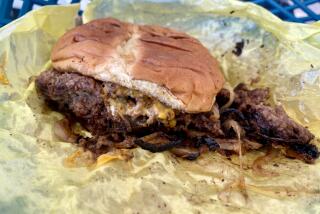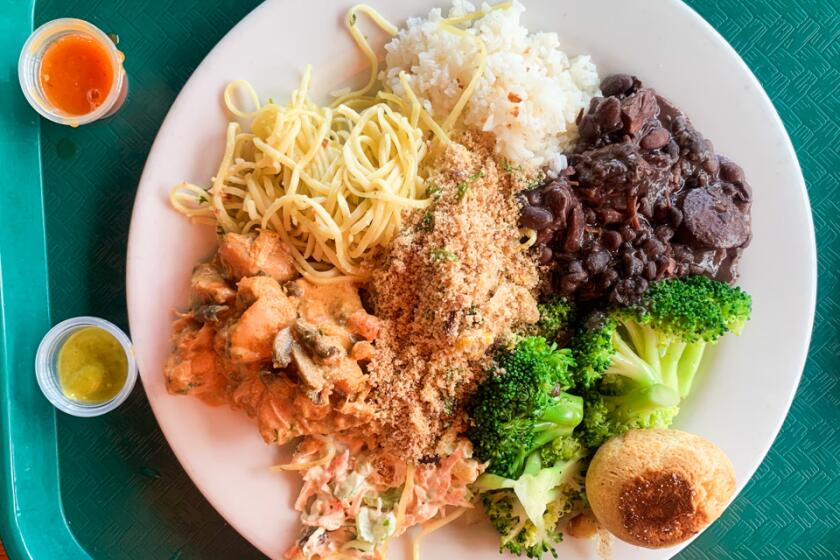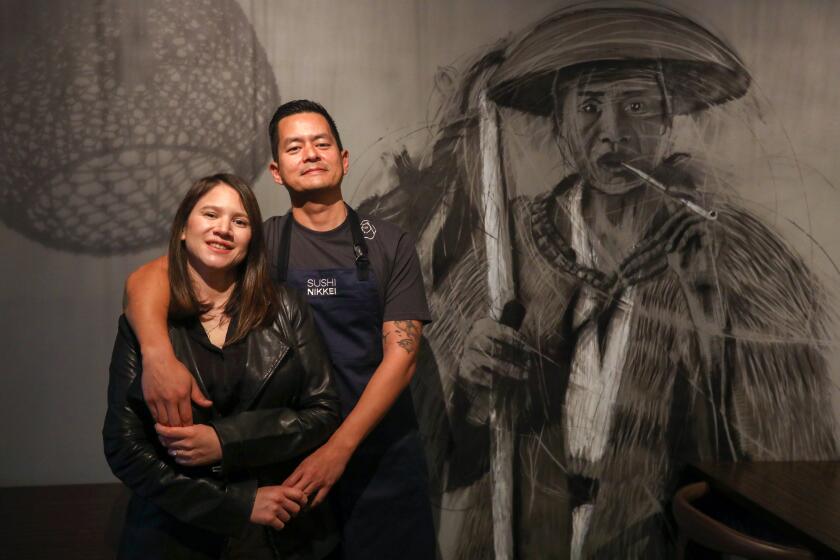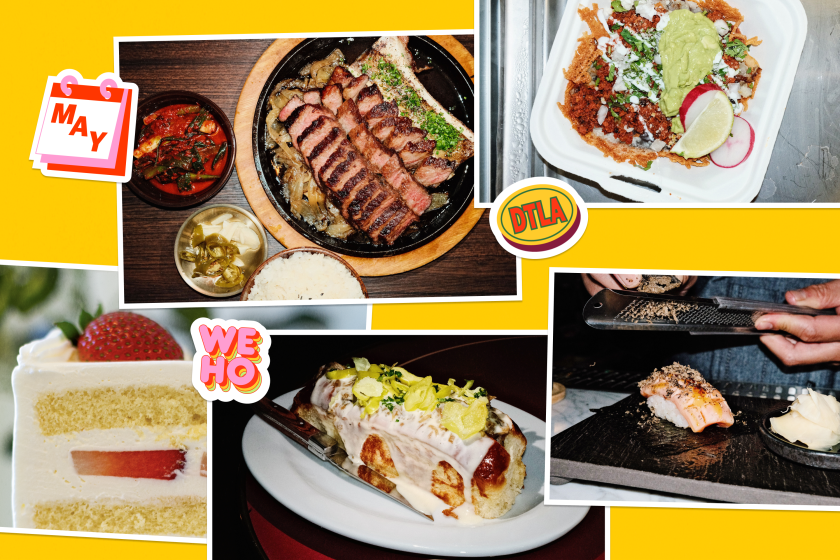BOOK REVIEW : Fiddling the Fat : Great Good Food: Luscious Lower-Fat Cooking, <i> By Julee Rosso</i> ; <i> Crown Publishers: $19; 574 pp. </i>
Julee Rosso’s warning about pes to stopped me dead in my tracks--and take heed, people who worry about fat in their diets--I chose that cliche on purpose. Did you know that pesto clogs in with 90% of its calories coming from fat? Mix it with pasta, she claims, and the percentage declines to 47%, but that’s still on the far side of 30% of your daily calorie intake, which is the daily fat intake recommended for adults.
It’s a troublesome bit of news, particularly for those of us who thought we had fat beat, having long since given up marbled beef and cheesecake in favor of politically correct carbohydrates. But no. There’s too much fat in pesto, in salad dressing, in a mountain of green beans dressed with a bit of olive oil. At first glance Rosso’s book is enough to make you phobic about everything but raw carrots--and maybe that’s what she has in mind. If even green beans are out to get you, then perhaps the only safe haven is a cookbook from a woman who swears she understands how we ought to eat.
Rosso, late of Silver Palate fame, sets out to retool the American diet with a born-again eater’s zeal and a batch of low-fat tricks. Five hundred and seventy two pages later, we have a handful of really good recipes, an equal serving of bewildering ones--and a frustrating sense that we’ve been had. It’s like the fashion mavens telling us that bell-bottoms redux are good for us, a sign of the free-spirited times. Just doesn’t ring true. How could it possibly be right to be worried about green beans?
It is if you go strictly by the numbers, which turns the world into a strange place, where a certain dessert is theoretically better for you than a vegetable. It’s a game of percentages where a Razzle Dazzle Raspberry Pie with 15 grams of fat (worth 26% of its calories) is deemed preferable to classic pesto with 11 grams of fat (which happen to account for most of its calories). What follows should (and could, given that Rosso doesn’t provide a sodium count in her recipes’ nutritional analyses) be taken with a grain of salt.
Some of Rosso’s recipes are revisions of the high-fat goodies that appeared in the two Silver Palate cookbooks. I was thrilled to find a low-fat version of the salmon mousse that a friend makes every holiday season. It’s gorgeous with mayonnaise and heavy cream, but Rosso assures the reader that her nouvelle version, dependent on egg whites and her “low-fat blend” of pureed nonfat yogurt and cottage cheese, is equally delectable.
So I made it, and we ate it with thinly sliced tomatoes open-faced on Izzy’s New York rye from the La Brea Bakery. There was much self-congratulation: Imagine how much lower the total fat content of this meal must be than it was in its original incarnation; why, this was the culinary equivalent of safe sex.
By the third helping, though, reality began to set in. Yogurt (which I love) has a tangy taste that tilted the overall flavor of the mousse and fought the richness of the salmon. As for the texture, there seemed to be teensy air holes that once had been filled by dense, rich cream.
But that’s just a question of taste. Someone whose arteries have shrunk from a size 8 to a size 2, whose medical life plan precludes dietary fat, might be perfectly happy eating any kind of mousse at all. The real problem--the ethical dilemma--is the price Rosso too often expects us to pay to get that fat percentage figure down to where she wants it.
The trade-offs are most blatant in the baked-goods recipes. Take the raspberry muffins. Commercial muffins are notoriously high in fat, so the idea of a tasty 17% fat alternative was seductive. I tried the blueberry version, wondering only in passing why 18 muffins required two whole cups of sugar. I wondered more actively when I tasted a muffin. It had a lovely consistency, just slightly chewy--but it was sweet enough to peel the enamel off your teeth. My 3 1/2-year-old daughter had helped mix the batter, and pride of ownership made her eager to taste the results. When she said the muffins were too sweet, I knew something was wrong.
Maybe it was a typo. The recipe did call for 12 muffin cups on a yield of 18 muffins, and I’d read another recipe that called for a measure of olive oil that was never used; Rosso is sloppy in her enthusiasm. Maybe it was supposed to be 1/2 cup. I tried again, and got a perfectly reasonable muffin whose sweetness no longer bullied the lemon zest and blueberries. But diminishing the sugar raised the fat percentage to 28%, still tolerable, but hardly the low-fat gold-mine of the sweeter recipe.
What’s going on here? Are we really supposed to eat too much sugar to make the same number of grams of fat look like less? Thanks, but no thanks. I recommend suspicion when approaching the baked goods.
Some of the main dishes are smarter and less sinister. Rosso offers a nice recipe for cod with garlic--fillets are marinated in lime juice and then quick-fried in a tiny amount of garlic-scented oil and butter. Cilantro offsets the creamy garlic, and all for a happy 6 grams of fat. I made the recipe with sea bass, as Rosso suggests, but it didn’t take well to the quick-fry, so a second time I simply roasted the marinated fish and made the sauce separately. Just as good. Joyce Goldstein’s “Back to Square One” offers a Yucatan marinade that knocks this recipe’s socks off, but it uses a lot of olive oil. Low-fat still seems to require sacrifice.
Or perhaps it just requires more work. Rosso is like a woman in love for the first time: excessive, abandoned, not as cautious as she might be, willing to overlook flaws, vulnerable to impassioned error. She offers 11 dips because dips, that mire of mayonnaise and sour cream, are where people usually get into trouble. Some of them sound terrific, and the lemon dip is surprisingly good. But the red pepper dip, as one friend put it, “tastes like it’s low-fat”--thin and slightly sour, a bit harsh.
Still, when it is good, the book is very, very good: A recipe called a hen and a hare, which calls for an odd assortment of ingredients and looks absolutely dreadful until the rice is added, is a lovely one-dish meal.
When this book is bad, it is horrid: inaccurate, confusing and playing by a questionable set of rules. I am interested in vegetable broths and purees replacing oil and butter. I am not interested in eating things that I think are bad for me just to make the numbers on a single dish look right.
But Rosso did nail the one recipe I cared about the most. The summer pesto, with one tablespoon of olive oil instead of the usual one-half cup, with buttermilk to thin it out, is absolutely swell, just in time for the season’s bumper crop of basil, and it weighs in with just four grams of fat.
More to Read
Eat your way across L.A.
Get our weekly Tasting Notes newsletter for reviews, news and more.
You may occasionally receive promotional content from the Los Angeles Times.






